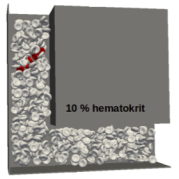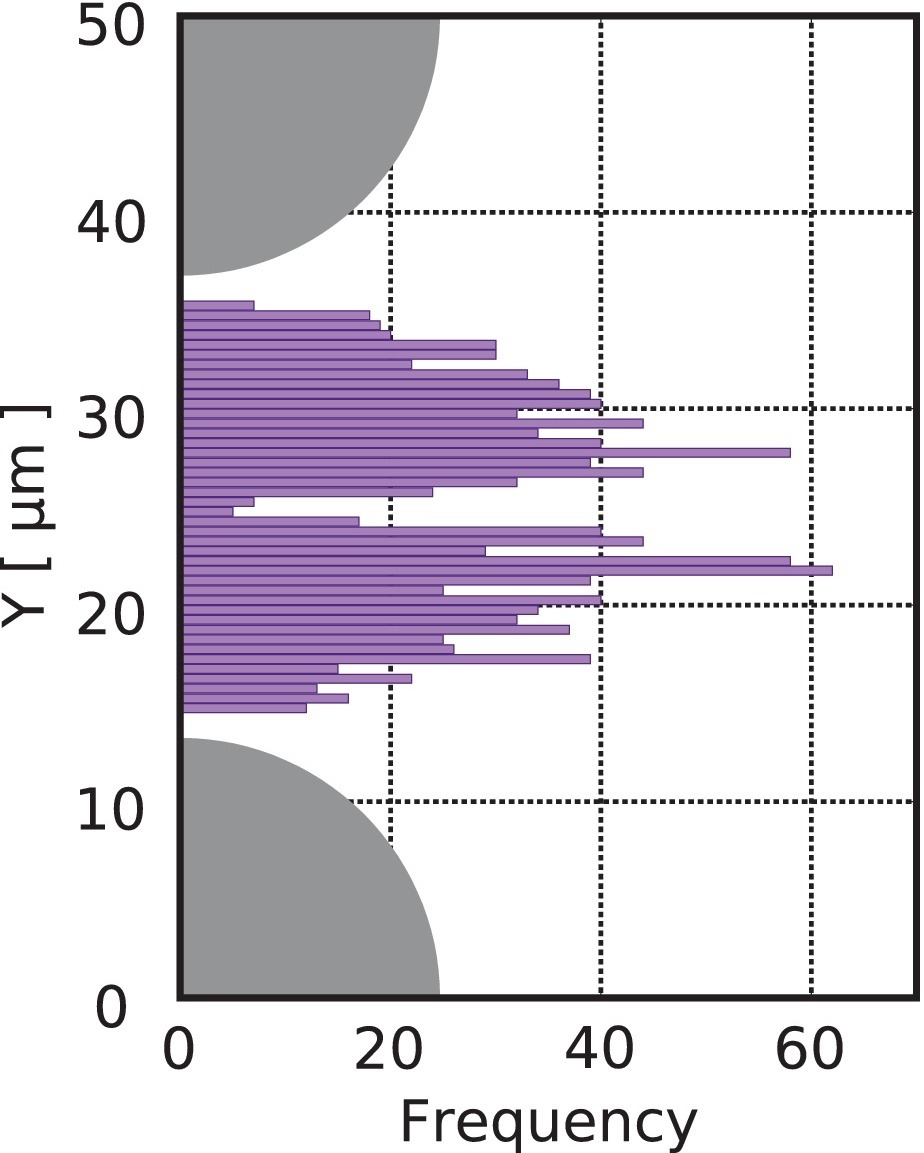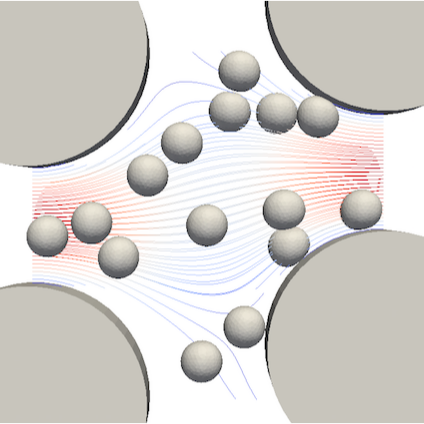Cell damage index
 Shear‐induced hemolysis is a major concern in the design and optimization of blood‐contacting devices. Even with a small amount of mechanical stress, inflammatory reactions can be triggered in the cells. Blood damage is typically estimated using continuum fluid dynamics simulations. We introduced and investigate cell damage index (CDI) obtained by simulations on the single‐cell level in a lattice Boltzmann fluid flow. The change of the cell surface area gives important information on mechanical stress of individual cells as well as for whole blood. The CDI can incorporate both volume fraction and channel geometry information into a single quantitative value for the characterization of flow in artificial chambers.
Shear‐induced hemolysis is a major concern in the design and optimization of blood‐contacting devices. Even with a small amount of mechanical stress, inflammatory reactions can be triggered in the cells. Blood damage is typically estimated using continuum fluid dynamics simulations. We introduced and investigate cell damage index (CDI) obtained by simulations on the single‐cell level in a lattice Boltzmann fluid flow. The change of the cell surface area gives important information on mechanical stress of individual cells as well as for whole blood. The CDI can incorporate both volume fraction and channel geometry information into a single quantitative value for the characterization of flow in artificial chambers.
More info:
- M. Gusenbauer, R. Tothova, G. Mazza, M. Brandl, T. Schrefl, I. Jancigova, I. Cimrak: Cell damage index as computational indicator for blood cell activation and damage, Artificial Organs, Vol. 42, No. 7, pp. 746-755, 2018
Periodic obstacle arrays
 Microfluidic devices that contain periodic obstacle arrays are frequently used for capture of rare cells such as circulating tumour cells (CTC). Detailed computational analysis can give valuable insights into understanding of fluidic processes inside such devices. Using our previously developed Object-in-fluid framework, we investigate characteristics of a single CTC in a suspension of red blood cells. In this work, we describe a new model for evaluation of cell capture probabilitythat includes the surface area of the cell-obstacle contact. We analyze individual trajectories of CTCs and their distribution between the obstacles during the transport through the device. We vary two parameters – hematocrit and column radius of the cylindrical obstacles. While the hematocrit has a slight influence on the CTC trajectories and the cell capture rate computed by the newly developed model, the effect of column radius is much more pronounced. We observe that increase in column radius increases the capture rate quadratically. And secondly, with the exception of the very small column radius, increase in hematocrit slightly decreases the capture rate linearly.
Microfluidic devices that contain periodic obstacle arrays are frequently used for capture of rare cells such as circulating tumour cells (CTC). Detailed computational analysis can give valuable insights into understanding of fluidic processes inside such devices. Using our previously developed Object-in-fluid framework, we investigate characteristics of a single CTC in a suspension of red blood cells. In this work, we describe a new model for evaluation of cell capture probabilitythat includes the surface area of the cell-obstacle contact. We analyze individual trajectories of CTCs and their distribution between the obstacles during the transport through the device. We vary two parameters – hematocrit and column radius of the cylindrical obstacles. While the hematocrit has a slight influence on the CTC trajectories and the cell capture rate computed by the newly developed model, the effect of column radius is much more pronounced. We observe that increase in column radius increases the capture rate quadratically. And secondly, with the exception of the very small column radius, increase in hematocrit slightly decreases the capture rate linearly.
More info:
- M. Busik, I. Jancigova, R. Tothova, I. Cimrak: Simulation study of rare cell trajectories and capture rate in periodic obstacle arrays, Journal of Computational Science, Vol. 17, No. 2, pp. 370-376, 2016
Collision rates
 Recently, computational modelling has been successfully used for determination of collision rates for rare cell capture in periodic obstacle arrays. The models were based on particle advection simulations where the cells were advected according to velocity field computed from two dimensional Navier-Stokes equations. This approach may be used under the assumption of very dilute cell suspensions where no mutual cell collisions occur. We use the object-in-fluid framework to demonstrate that even with low cell-to-fluid ratio, the optimal geometry of the obstacle array significantly changes. We show computational simulations for ratios of 3.5, 6.9 and 10.4% determining the optimal geometry of the periodic obstacle arrays. It was already previously demonstrated that cells in periodic obstacle arrays follow trajectories in two modes: the colliding mode and the zig-zag mode. The colliding mode maximizes the cell-obstacle collision frequency. Our simulations reveal that for dilute suspensions and for suspensions with cell-to-fluid ratio 3.5%, there is a range of column shifts for which the cells follow colliding trajectories. However we showed, that for 6.9 and 10.4%, the cells never follow colliding trajectories.
Recently, computational modelling has been successfully used for determination of collision rates for rare cell capture in periodic obstacle arrays. The models were based on particle advection simulations where the cells were advected according to velocity field computed from two dimensional Navier-Stokes equations. This approach may be used under the assumption of very dilute cell suspensions where no mutual cell collisions occur. We use the object-in-fluid framework to demonstrate that even with low cell-to-fluid ratio, the optimal geometry of the obstacle array significantly changes. We show computational simulations for ratios of 3.5, 6.9 and 10.4% determining the optimal geometry of the periodic obstacle arrays. It was already previously demonstrated that cells in periodic obstacle arrays follow trajectories in two modes: the colliding mode and the zig-zag mode. The colliding mode maximizes the cell-obstacle collision frequency. Our simulations reveal that for dilute suspensions and for suspensions with cell-to-fluid ratio 3.5%, there is a range of column shifts for which the cells follow colliding trajectories. However we showed, that for 6.9 and 10.4%, the cells never follow colliding trajectories.
More info:
- I. Cimrak: Collision rates for rare cell capture in periodic obstacle arrays strongly depend on density of cell suspension, Computer Methods in Biomechanics and Biomedical Engineering, Vol. 19, No. 14, pp. 1525-1530, 2016